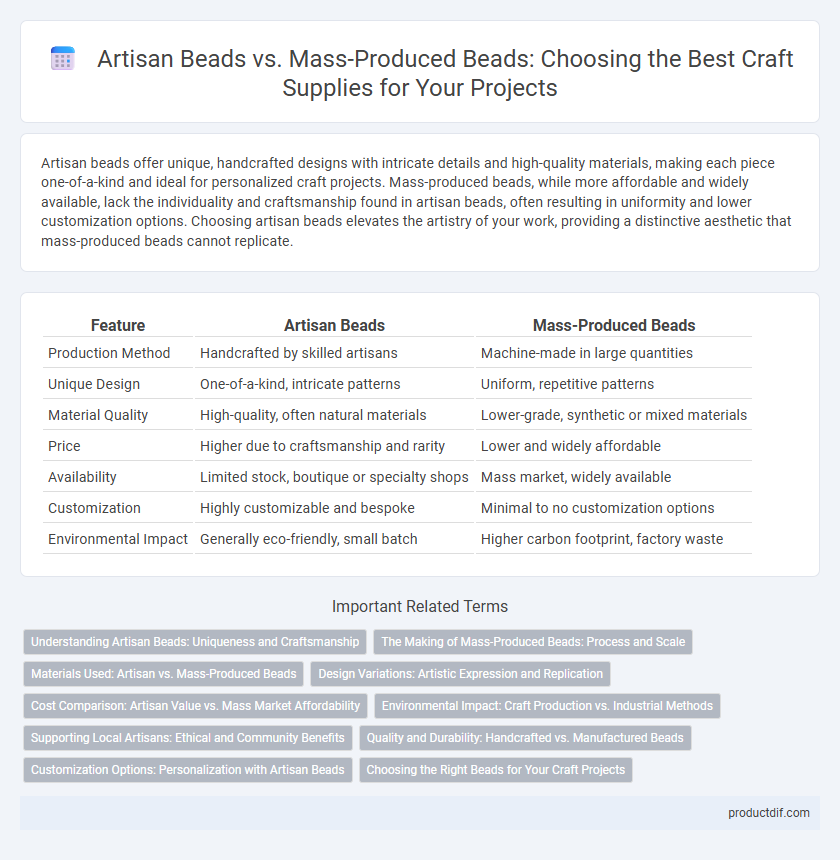Artisan beads offer unique, handcrafted designs with intricate details and high-quality materials, making each piece one-of-a-kind and ideal for personalized craft projects. Mass-produced beads, while more affordable and widely available, lack the individuality and craftsmanship found in artisan beads, often resulting in uniformity and lower customization options. Choosing artisan beads elevates the artistry of your work, providing a distinctive aesthetic that mass-produced beads cannot replicate.
Table of Comparison
| Feature | Artisan Beads | Mass-Produced Beads |
|---|---|---|
| Production Method | Handcrafted by skilled artisans | Machine-made in large quantities |
| Unique Design | One-of-a-kind, intricate patterns | Uniform, repetitive patterns |
| Material Quality | High-quality, often natural materials | Lower-grade, synthetic or mixed materials |
| Price | Higher due to craftsmanship and rarity | Lower and widely affordable |
| Availability | Limited stock, boutique or specialty shops | Mass market, widely available |
| Customization | Highly customizable and bespoke | Minimal to no customization options |
| Environmental Impact | Generally eco-friendly, small batch | Higher carbon footprint, factory waste |
Understanding Artisan Beads: Uniqueness and Craftsmanship
Artisan beads showcase unparalleled uniqueness and craftsmanship, often handcrafted in small batches by skilled artisans using high-quality materials such as glass, clay, or metal alloys. Unlike mass-produced beads, artisan beads feature intricate designs, subtle imperfections, and distinctive textures that enhance the aesthetic value of handmade jewelry and craft projects. Their exclusivity and attention to detail make artisan beads a preferred choice for creators seeking originality and authenticity in their craft supplies.
The Making of Mass-Produced Beads: Process and Scale
Mass-produced beads are created using automated machinery that shapes and polishes thousands of beads simultaneously, ensuring uniform size and shape for large-scale distribution. The process often involves injection molding or machine-driven cutting, allowing for consistent quality at high speeds that cater to commercial demand. This industrialized production method contrasts with handcrafted artisan beads, which emphasize individuality and intricate detailing.
Materials Used: Artisan vs. Mass-Produced Beads
Artisan beads are crafted using high-quality, natural materials such as glass, semi-precious stones, and metals, emphasizing unique textures and colors that reflect traditional handcrafting techniques. Mass-produced beads commonly utilize synthetic materials like plastic or resin, which allow for uniform shapes and lower production costs but lack the distinctiveness and durability of artisan beads. The choice of materials directly impacts the beads' aesthetic appeal, longevity, and suitability for premium craft projects.
Design Variations: Artistic Expression and Replication
Artisan beads showcase unique design variations that highlight individual craftsmanship and artistic expression, often resulting in one-of-a-kind pieces with intricate details and vibrant colors. In contrast, mass-produced beads prioritize uniformity and replication, producing large quantities with consistent shapes and patterns but limited originality. This distinction makes artisan beads ideal for personalized, creative projects while mass-produced beads suit standardized, cost-effective crafting needs.
Cost Comparison: Artisan Value vs. Mass Market Affordability
Artisan beads typically command higher prices due to handcrafted techniques, unique designs, and limited production runs, offering exceptional quality and individuality for craft projects. Mass-produced beads benefit from economies of scale, resulting in significantly lower costs but often at the expense of distinctiveness and material quality. Craft enthusiasts seeking exclusive, high-quality materials prioritize artisan beads despite the premium price, while hobbyists on a budget frequently choose mass-market options for affordability.
Environmental Impact: Craft Production vs. Industrial Methods
Artisan beads are typically crafted using sustainable materials and low-energy techniques, resulting in a smaller carbon footprint compared to mass-produced beads. Industrial methods often rely on synthetic materials and high-volume manufacturing processes that generate significant waste and pollution. Choosing artisan beads supports eco-friendly practices and reduces environmental degradation associated with large-scale bead production.
Supporting Local Artisans: Ethical and Community Benefits
Artisan beads offer unique designs crafted by skilled local artisans, ensuring each piece supports ethical labor practices and sustains community livelihoods. Unlike mass-produced beads, which often rely on automated processes and exploit cheap labor, artisan beads promote fair wages and preserve cultural heritage. Purchasing from local artisans strengthens community economies and fosters environmentally responsible production methods.
Quality and Durability: Handcrafted vs. Manufactured Beads
Artisan beads exhibit superior quality and durability due to meticulous handcrafting techniques that ensure unique finishes and precise detail. In contrast, mass-produced beads often compromise on consistency and durability because of automated manufacturing processes prioritizing quantity over individual quality. The distinct materials and craftsmanship in artisan beads result in longer-lasting, resilient products favored by crafters seeking premium supplies.
Customization Options: Personalization with Artisan Beads
Artisan beads offer unparalleled customization options, allowing crafters to personalize their projects with unique shapes, colors, and textures that mass-produced beads cannot match. Each artisan bead is handmade, providing distinct variations that add character and individuality to jewelry and craft items. This level of personalization enhances the value and creativity of finished pieces, making artisan beads the preferred choice for bespoke designs.
Choosing the Right Beads for Your Craft Projects
Artisan beads offer unique designs, handcrafted quality, and a distinct aesthetic that enhances personalized craft projects, setting them apart from uniformly shaped and lower-cost mass-produced beads. Choosing artisan beads boosts the originality and value of your creations, making them ideal for intricate jewelry, detailed embroidery, or custom beadwork. Mass-produced beads suit larger-scale or budget-friendly projects where consistency and volume are key, but they lack the distinct character brought by artisan craftsmanship.
Artisan beads vs Mass-produced beads Infographic

 productdif.com
productdif.com